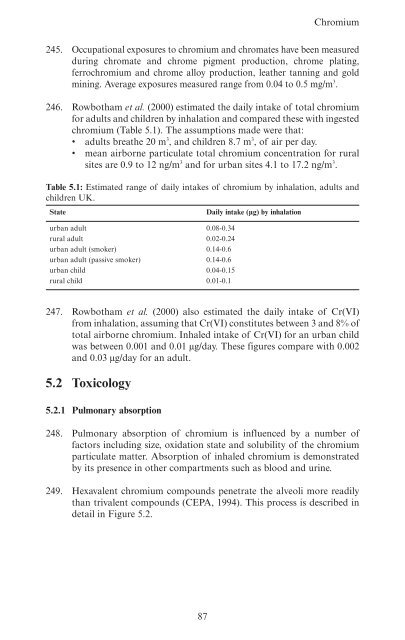Guidelines for Metals and Metalloids in Ambient ... - ARCHIVE: Defra
Guidelines for Metals and Metalloids in Ambient ... - ARCHIVE: Defra
Guidelines for Metals and Metalloids in Ambient ... - ARCHIVE: Defra
Create successful ePaper yourself
Turn your PDF publications into a flip-book with our unique Google optimized e-Paper software.
Chromium<br />
245. Occupational exposures to chromium <strong>and</strong> chromates have been measured<br />
dur<strong>in</strong>g chromate <strong>and</strong> chrome pigment production, chrome plat<strong>in</strong>g,<br />
ferrochromium <strong>and</strong> chrome alloy production, leather tann<strong>in</strong>g <strong>and</strong> gold<br />
m<strong>in</strong><strong>in</strong>g. Average exposures measured range from 0.04 to 0.5 mg/m 3 .<br />
246. Rowbotham et al. (2000) estimated the daily <strong>in</strong>take of total chromium<br />
<strong>for</strong> adults <strong>and</strong> children by <strong>in</strong>halation <strong>and</strong> compared these with <strong>in</strong>gested<br />
chromium (Table 5.1). The assumptions made were that:<br />
• adults breathe 20 m 3 , <strong>and</strong> children 8.7 m 3 , of air per day.<br />
• mean airborne particulate total chromium concentration <strong>for</strong> rural<br />
sites are 0.9 to 12 ng/m 3 <strong>and</strong> <strong>for</strong> urban sites 4.1 to 17.2 ng/m 3 .<br />
Table 5.1: Estimated range of daily <strong>in</strong>takes of chromium by <strong>in</strong>halation, adults <strong>and</strong><br />
children UK.<br />
State<br />
Daily <strong>in</strong>take (µg) by <strong>in</strong>halation<br />
urban adult<br />
rural adult<br />
urban adult (smoker)<br />
urban adult (passive smoker)<br />
urban child<br />
rural child<br />
0.08-0.34<br />
0.02-0.24<br />
0.14-0.6<br />
0.14-0.6<br />
0.04-0.15<br />
0.01-0.1<br />
247. Rowbotham et al. (2000) also estimated the daily <strong>in</strong>take of Cr(VI)<br />
from <strong>in</strong>halation, assum<strong>in</strong>g that Cr(VI) constitutes between 3 <strong>and</strong> 8% of<br />
total airborne chromium. Inhaled <strong>in</strong>take of Cr(VI) <strong>for</strong> an urban child<br />
was between 0.001 <strong>and</strong> 0.01 µg/day. These figures compare with 0.002<br />
<strong>and</strong> 0.03 µg/day <strong>for</strong> an adult.<br />
5.2 Toxicology<br />
5.2.1 Pulmonary absorption<br />
248. Pulmonary absorption of chromium is <strong>in</strong>fluenced by a number of<br />
factors <strong>in</strong>clud<strong>in</strong>g size, oxidation state <strong>and</strong> solubility of the chromium<br />
particulate matter. Absorption of <strong>in</strong>haled chromium is demonstrated<br />
by its presence <strong>in</strong> other compartments such as blood <strong>and</strong> ur<strong>in</strong>e.<br />
249. Hexavalent chromium compounds penetrate the alveoli more readily<br />
than trivalent compounds (CEPA, 1994). This process is described <strong>in</strong><br />
detail <strong>in</strong> Figure 5.2.<br />
87
















